Holmes Institute HA3011: Advanced Financial Accounting Report
VerifiedAdded on 2022/08/23
|13
|2946
|18
Report
AI Summary
This report provides an in-depth analysis of the reporting entity concept in Australian financial accounting, focusing on the application of the differential reporting method. It examines the criteria for identifying a reporting entity, using Bellamy's Australia Limited as a case study. The report highlights the importance of relevance and representational faithfulness as key qualitative characteristics, as recognized in the IASB Conceptual Framework, for the usefulness of financial information. The study also discusses the Australian accounting regulatory framework and the influence of the conceptual framework on accounting practice. The report emphasizes that for financial statements to be useful, the information must be both relevant and a faithful representation of the economic circumstances it aims to portray. The report also touches on the accounting standards and the process of accounting for assets, non-current assets and liabilities.
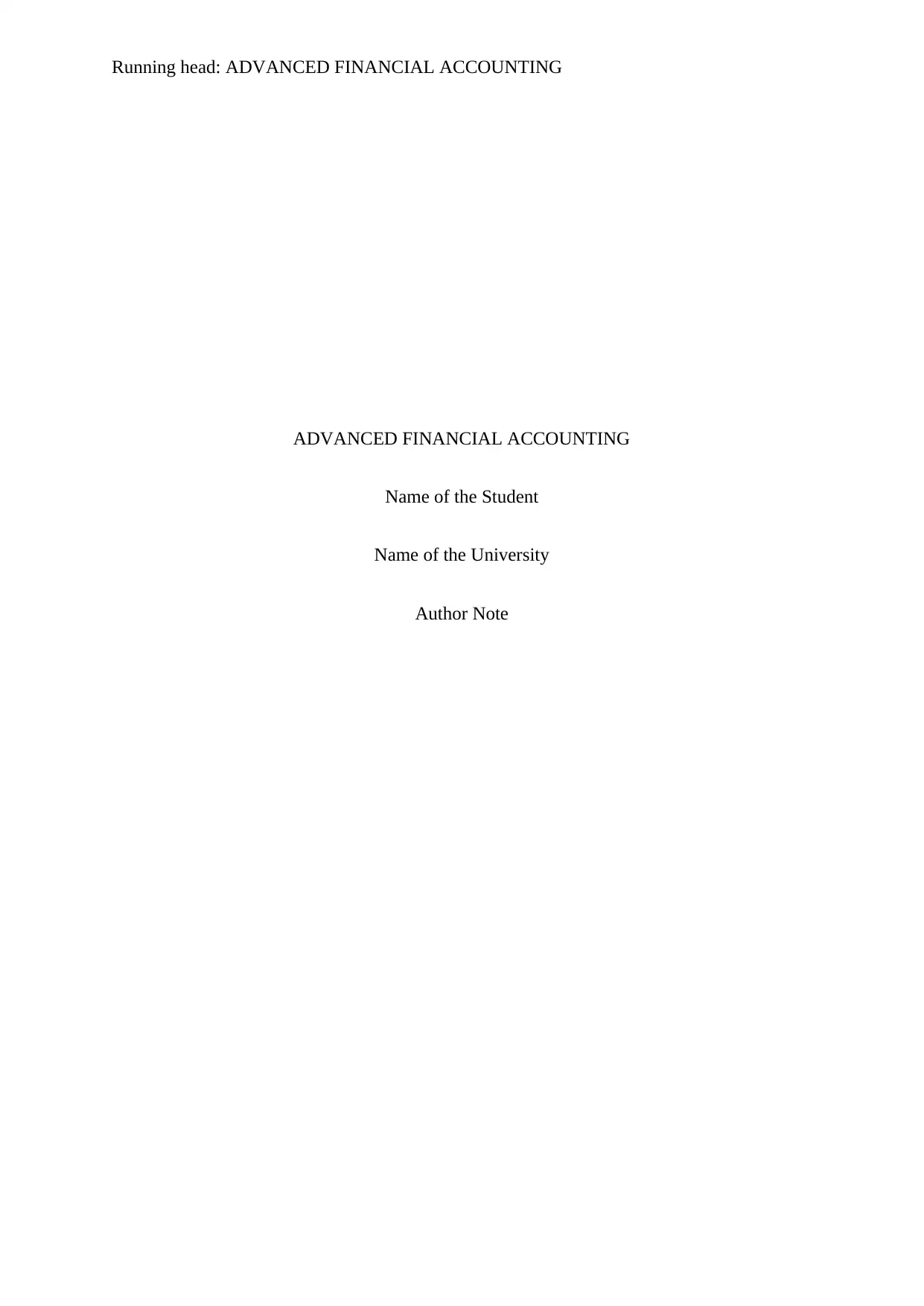
Running head: ADVANCED FINANCIAL ACCOUNTING
ADVANCED FINANCIAL ACCOUNTING
Name of the Student
Name of the University
Author Note
ADVANCED FINANCIAL ACCOUNTING
Name of the Student
Name of the University
Author Note
Paraphrase This Document
Need a fresh take? Get an instant paraphrase of this document with our AI Paraphraser
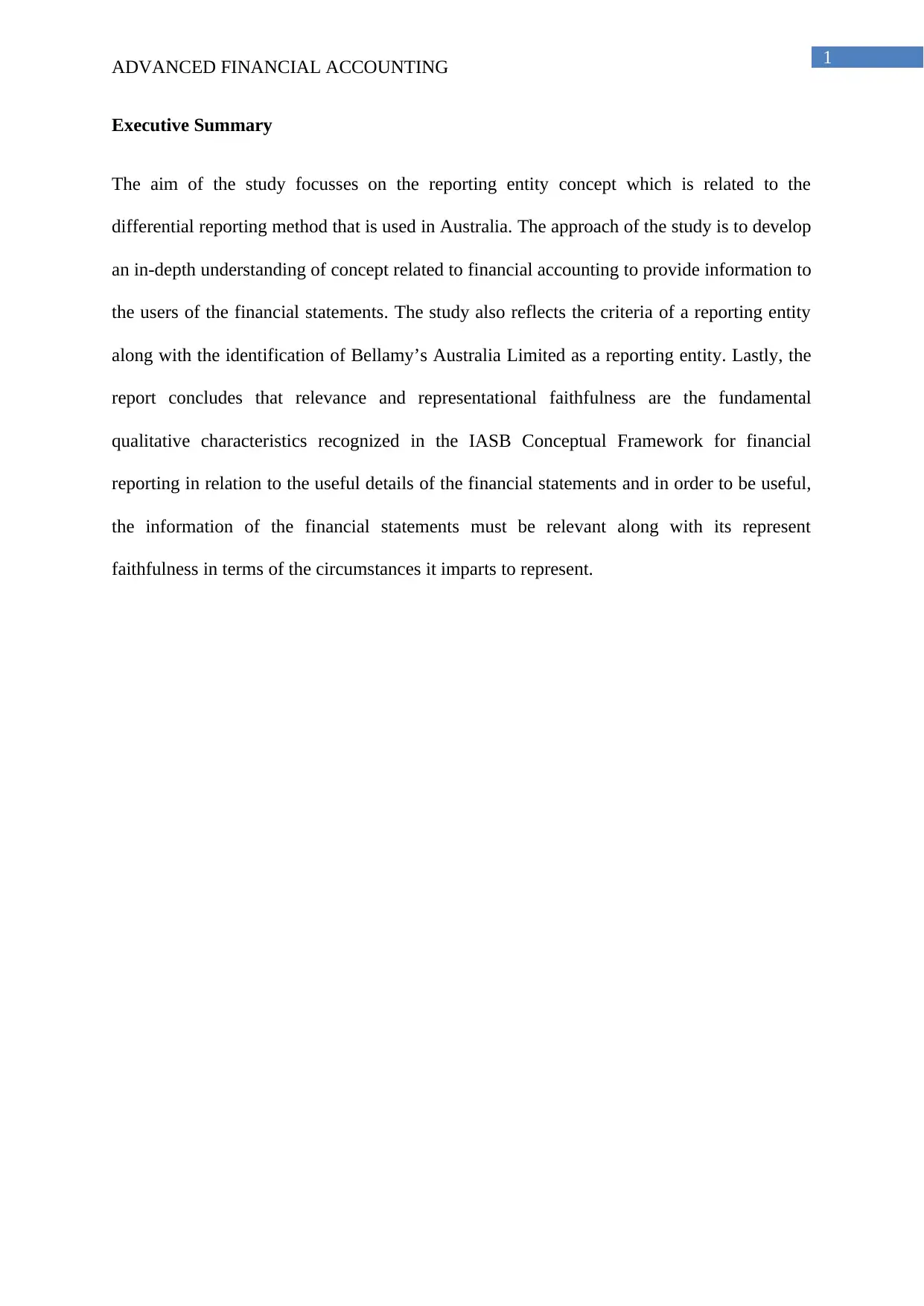
1
ADVANCED FINANCIAL ACCOUNTING
Executive Summary
The aim of the study focusses on the reporting entity concept which is related to the
differential reporting method that is used in Australia. The approach of the study is to develop
an in-depth understanding of concept related to financial accounting to provide information to
the users of the financial statements. The study also reflects the criteria of a reporting entity
along with the identification of Bellamy’s Australia Limited as a reporting entity. Lastly, the
report concludes that relevance and representational faithfulness are the fundamental
qualitative characteristics recognized in the IASB Conceptual Framework for financial
reporting in relation to the useful details of the financial statements and in order to be useful,
the information of the financial statements must be relevant along with its represent
faithfulness in terms of the circumstances it imparts to represent.
ADVANCED FINANCIAL ACCOUNTING
Executive Summary
The aim of the study focusses on the reporting entity concept which is related to the
differential reporting method that is used in Australia. The approach of the study is to develop
an in-depth understanding of concept related to financial accounting to provide information to
the users of the financial statements. The study also reflects the criteria of a reporting entity
along with the identification of Bellamy’s Australia Limited as a reporting entity. Lastly, the
report concludes that relevance and representational faithfulness are the fundamental
qualitative characteristics recognized in the IASB Conceptual Framework for financial
reporting in relation to the useful details of the financial statements and in order to be useful,
the information of the financial statements must be relevant along with its represent
faithfulness in terms of the circumstances it imparts to represent.
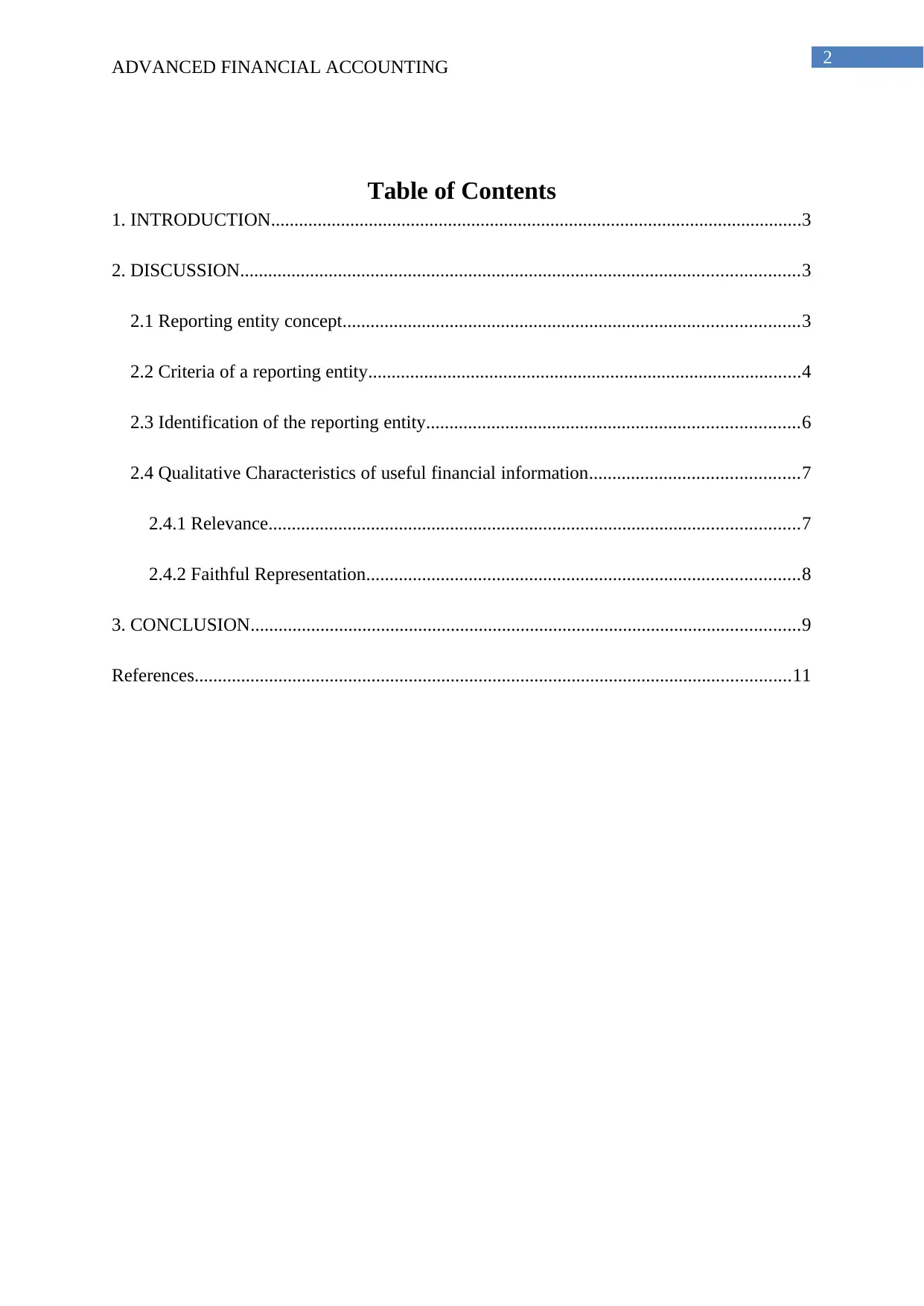
2
ADVANCED FINANCIAL ACCOUNTING
Table of Contents
1. INTRODUCTION..................................................................................................................3
2. DISCUSSION........................................................................................................................3
2.1 Reporting entity concept..................................................................................................3
2.2 Criteria of a reporting entity.............................................................................................4
2.3 Identification of the reporting entity................................................................................6
2.4 Qualitative Characteristics of useful financial information.............................................7
2.4.1 Relevance..................................................................................................................7
2.4.2 Faithful Representation.............................................................................................8
3. CONCLUSION......................................................................................................................9
References................................................................................................................................11
ADVANCED FINANCIAL ACCOUNTING
Table of Contents
1. INTRODUCTION..................................................................................................................3
2. DISCUSSION........................................................................................................................3
2.1 Reporting entity concept..................................................................................................3
2.2 Criteria of a reporting entity.............................................................................................4
2.3 Identification of the reporting entity................................................................................6
2.4 Qualitative Characteristics of useful financial information.............................................7
2.4.1 Relevance..................................................................................................................7
2.4.2 Faithful Representation.............................................................................................8
3. CONCLUSION......................................................................................................................9
References................................................................................................................................11
⊘ This is a preview!⊘
Do you want full access?
Subscribe today to unlock all pages.

Trusted by 1+ million students worldwide
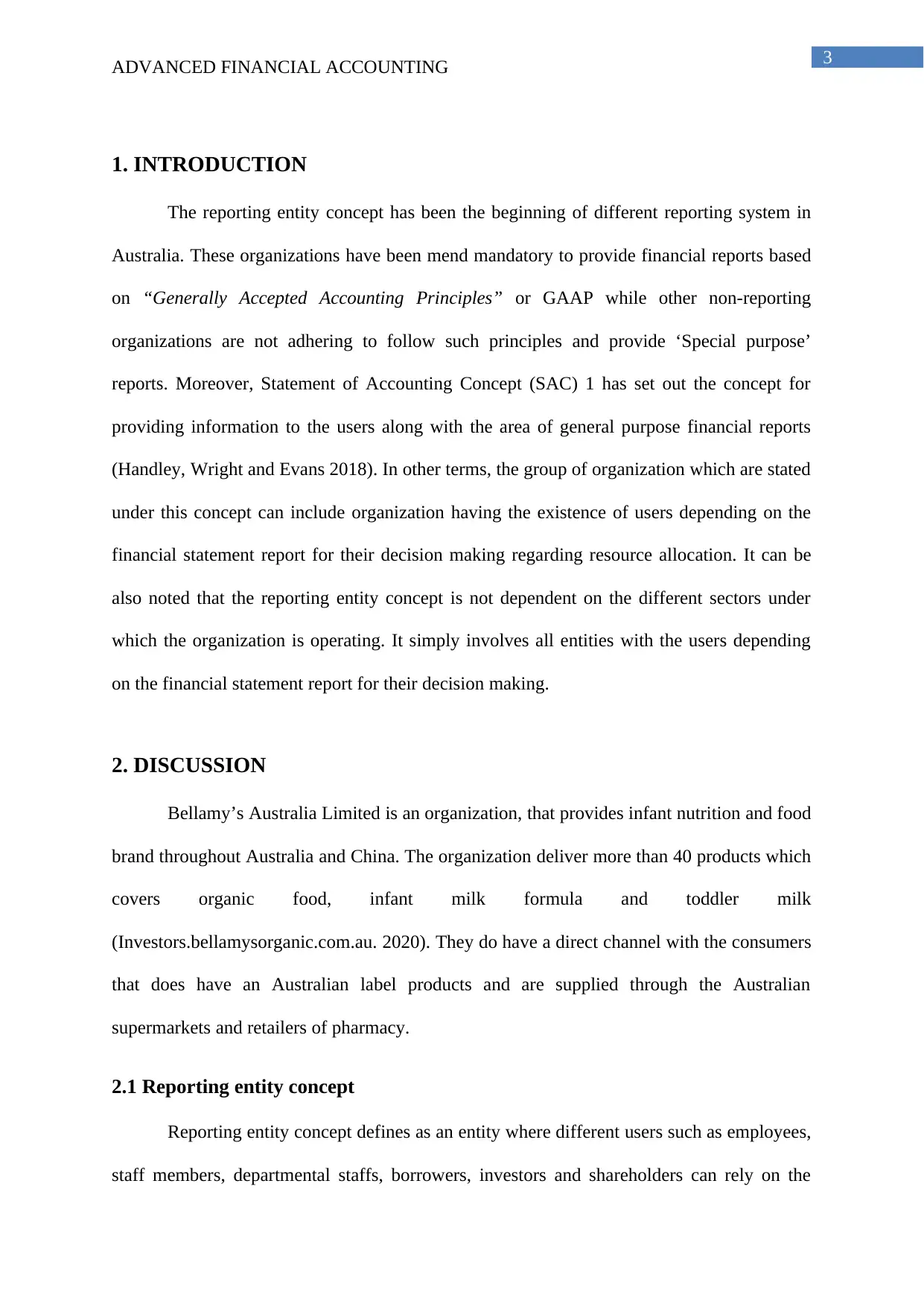
3
ADVANCED FINANCIAL ACCOUNTING
1. INTRODUCTION
The reporting entity concept has been the beginning of different reporting system in
Australia. These organizations have been mend mandatory to provide financial reports based
on “Generally Accepted Accounting Principles” or GAAP while other non-reporting
organizations are not adhering to follow such principles and provide ‘Special purpose’
reports. Moreover, Statement of Accounting Concept (SAC) 1 has set out the concept for
providing information to the users along with the area of general purpose financial reports
(Handley, Wright and Evans 2018). In other terms, the group of organization which are stated
under this concept can include organization having the existence of users depending on the
financial statement report for their decision making regarding resource allocation. It can be
also noted that the reporting entity concept is not dependent on the different sectors under
which the organization is operating. It simply involves all entities with the users depending
on the financial statement report for their decision making.
2. DISCUSSION
Bellamy’s Australia Limited is an organization, that provides infant nutrition and food
brand throughout Australia and China. The organization deliver more than 40 products which
covers organic food, infant milk formula and toddler milk
(Investors.bellamysorganic.com.au. 2020). They do have a direct channel with the consumers
that does have an Australian label products and are supplied through the Australian
supermarkets and retailers of pharmacy.
2.1 Reporting entity concept
Reporting entity concept defines as an entity where different users such as employees,
staff members, departmental staffs, borrowers, investors and shareholders can rely on the
ADVANCED FINANCIAL ACCOUNTING
1. INTRODUCTION
The reporting entity concept has been the beginning of different reporting system in
Australia. These organizations have been mend mandatory to provide financial reports based
on “Generally Accepted Accounting Principles” or GAAP while other non-reporting
organizations are not adhering to follow such principles and provide ‘Special purpose’
reports. Moreover, Statement of Accounting Concept (SAC) 1 has set out the concept for
providing information to the users along with the area of general purpose financial reports
(Handley, Wright and Evans 2018). In other terms, the group of organization which are stated
under this concept can include organization having the existence of users depending on the
financial statement report for their decision making regarding resource allocation. It can be
also noted that the reporting entity concept is not dependent on the different sectors under
which the organization is operating. It simply involves all entities with the users depending
on the financial statement report for their decision making.
2. DISCUSSION
Bellamy’s Australia Limited is an organization, that provides infant nutrition and food
brand throughout Australia and China. The organization deliver more than 40 products which
covers organic food, infant milk formula and toddler milk
(Investors.bellamysorganic.com.au. 2020). They do have a direct channel with the consumers
that does have an Australian label products and are supplied through the Australian
supermarkets and retailers of pharmacy.
2.1 Reporting entity concept
Reporting entity concept defines as an entity where different users such as employees,
staff members, departmental staffs, borrowers, investors and shareholders can rely on the
Paraphrase This Document
Need a fresh take? Get an instant paraphrase of this document with our AI Paraphraser
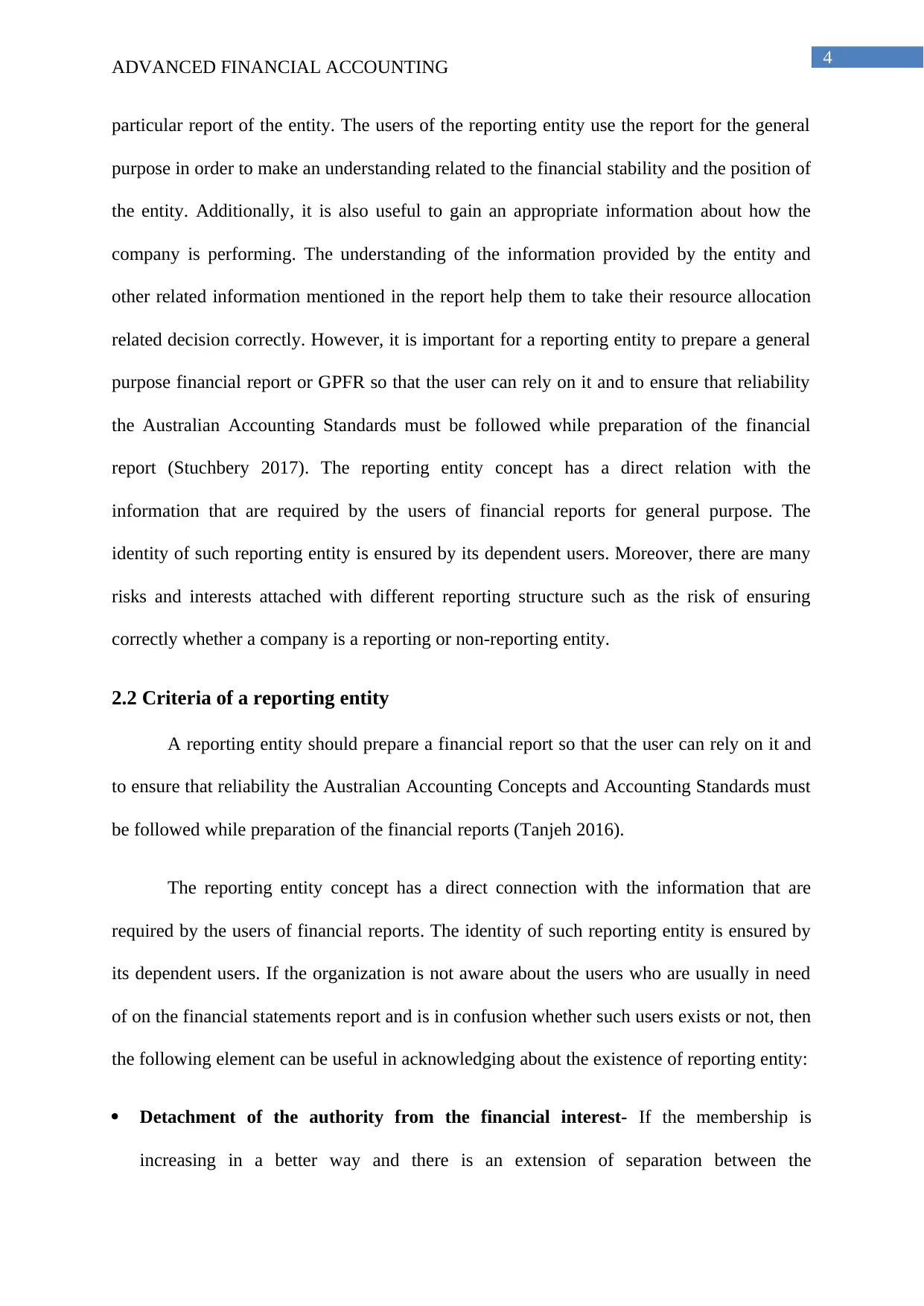
4
ADVANCED FINANCIAL ACCOUNTING
particular report of the entity. The users of the reporting entity use the report for the general
purpose in order to make an understanding related to the financial stability and the position of
the entity. Additionally, it is also useful to gain an appropriate information about how the
company is performing. The understanding of the information provided by the entity and
other related information mentioned in the report help them to take their resource allocation
related decision correctly. However, it is important for a reporting entity to prepare a general
purpose financial report or GPFR so that the user can rely on it and to ensure that reliability
the Australian Accounting Standards must be followed while preparation of the financial
report (Stuchbery 2017). The reporting entity concept has a direct relation with the
information that are required by the users of financial reports for general purpose. The
identity of such reporting entity is ensured by its dependent users. Moreover, there are many
risks and interests attached with different reporting structure such as the risk of ensuring
correctly whether a company is a reporting or non-reporting entity.
2.2 Criteria of a reporting entity
A reporting entity should prepare a financial report so that the user can rely on it and
to ensure that reliability the Australian Accounting Concepts and Accounting Standards must
be followed while preparation of the financial reports (Tanjeh 2016).
The reporting entity concept has a direct connection with the information that are
required by the users of financial reports. The identity of such reporting entity is ensured by
its dependent users. If the organization is not aware about the users who are usually in need
of on the financial statements report and is in confusion whether such users exists or not, then
the following element can be useful in acknowledging about the existence of reporting entity:
Detachment of the authority from the financial interest- If the membership is
increasing in a better way and there is an extension of separation between the
ADVANCED FINANCIAL ACCOUNTING
particular report of the entity. The users of the reporting entity use the report for the general
purpose in order to make an understanding related to the financial stability and the position of
the entity. Additionally, it is also useful to gain an appropriate information about how the
company is performing. The understanding of the information provided by the entity and
other related information mentioned in the report help them to take their resource allocation
related decision correctly. However, it is important for a reporting entity to prepare a general
purpose financial report or GPFR so that the user can rely on it and to ensure that reliability
the Australian Accounting Standards must be followed while preparation of the financial
report (Stuchbery 2017). The reporting entity concept has a direct relation with the
information that are required by the users of financial reports for general purpose. The
identity of such reporting entity is ensured by its dependent users. Moreover, there are many
risks and interests attached with different reporting structure such as the risk of ensuring
correctly whether a company is a reporting or non-reporting entity.
2.2 Criteria of a reporting entity
A reporting entity should prepare a financial report so that the user can rely on it and
to ensure that reliability the Australian Accounting Concepts and Accounting Standards must
be followed while preparation of the financial reports (Tanjeh 2016).
The reporting entity concept has a direct connection with the information that are
required by the users of financial reports. The identity of such reporting entity is ensured by
its dependent users. If the organization is not aware about the users who are usually in need
of on the financial statements report and is in confusion whether such users exists or not, then
the following element can be useful in acknowledging about the existence of reporting entity:
Detachment of the authority from the financial interest- If the membership is
increasing in a better way and there is an extension of separation between the
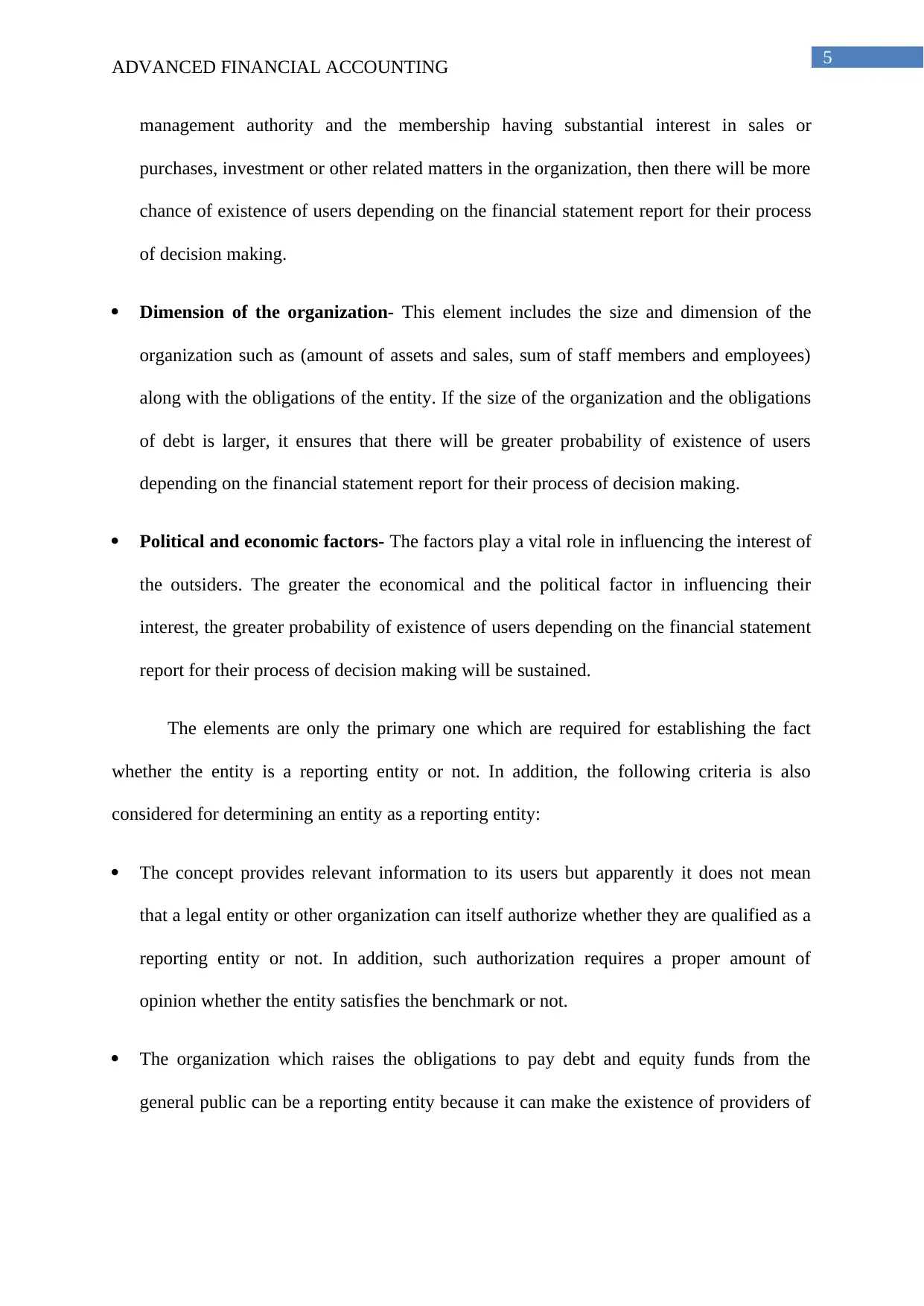
5
ADVANCED FINANCIAL ACCOUNTING
management authority and the membership having substantial interest in sales or
purchases, investment or other related matters in the organization, then there will be more
chance of existence of users depending on the financial statement report for their process
of decision making.
Dimension of the organization- This element includes the size and dimension of the
organization such as (amount of assets and sales, sum of staff members and employees)
along with the obligations of the entity. If the size of the organization and the obligations
of debt is larger, it ensures that there will be greater probability of existence of users
depending on the financial statement report for their process of decision making.
Political and economic factors- The factors play a vital role in influencing the interest of
the outsiders. The greater the economical and the political factor in influencing their
interest, the greater probability of existence of users depending on the financial statement
report for their process of decision making will be sustained.
The elements are only the primary one which are required for establishing the fact
whether the entity is a reporting entity or not. In addition, the following criteria is also
considered for determining an entity as a reporting entity:
The concept provides relevant information to its users but apparently it does not mean
that a legal entity or other organization can itself authorize whether they are qualified as a
reporting entity or not. In addition, such authorization requires a proper amount of
opinion whether the entity satisfies the benchmark or not.
The organization which raises the obligations to pay debt and equity funds from the
general public can be a reporting entity because it can make the existence of providers of
ADVANCED FINANCIAL ACCOUNTING
management authority and the membership having substantial interest in sales or
purchases, investment or other related matters in the organization, then there will be more
chance of existence of users depending on the financial statement report for their process
of decision making.
Dimension of the organization- This element includes the size and dimension of the
organization such as (amount of assets and sales, sum of staff members and employees)
along with the obligations of the entity. If the size of the organization and the obligations
of debt is larger, it ensures that there will be greater probability of existence of users
depending on the financial statement report for their process of decision making.
Political and economic factors- The factors play a vital role in influencing the interest of
the outsiders. The greater the economical and the political factor in influencing their
interest, the greater probability of existence of users depending on the financial statement
report for their process of decision making will be sustained.
The elements are only the primary one which are required for establishing the fact
whether the entity is a reporting entity or not. In addition, the following criteria is also
considered for determining an entity as a reporting entity:
The concept provides relevant information to its users but apparently it does not mean
that a legal entity or other organization can itself authorize whether they are qualified as a
reporting entity or not. In addition, such authorization requires a proper amount of
opinion whether the entity satisfies the benchmark or not.
The organization which raises the obligations to pay debt and equity funds from the
general public can be a reporting entity because it can make the existence of providers of
⊘ This is a preview!⊘
Do you want full access?
Subscribe today to unlock all pages.

Trusted by 1+ million students worldwide
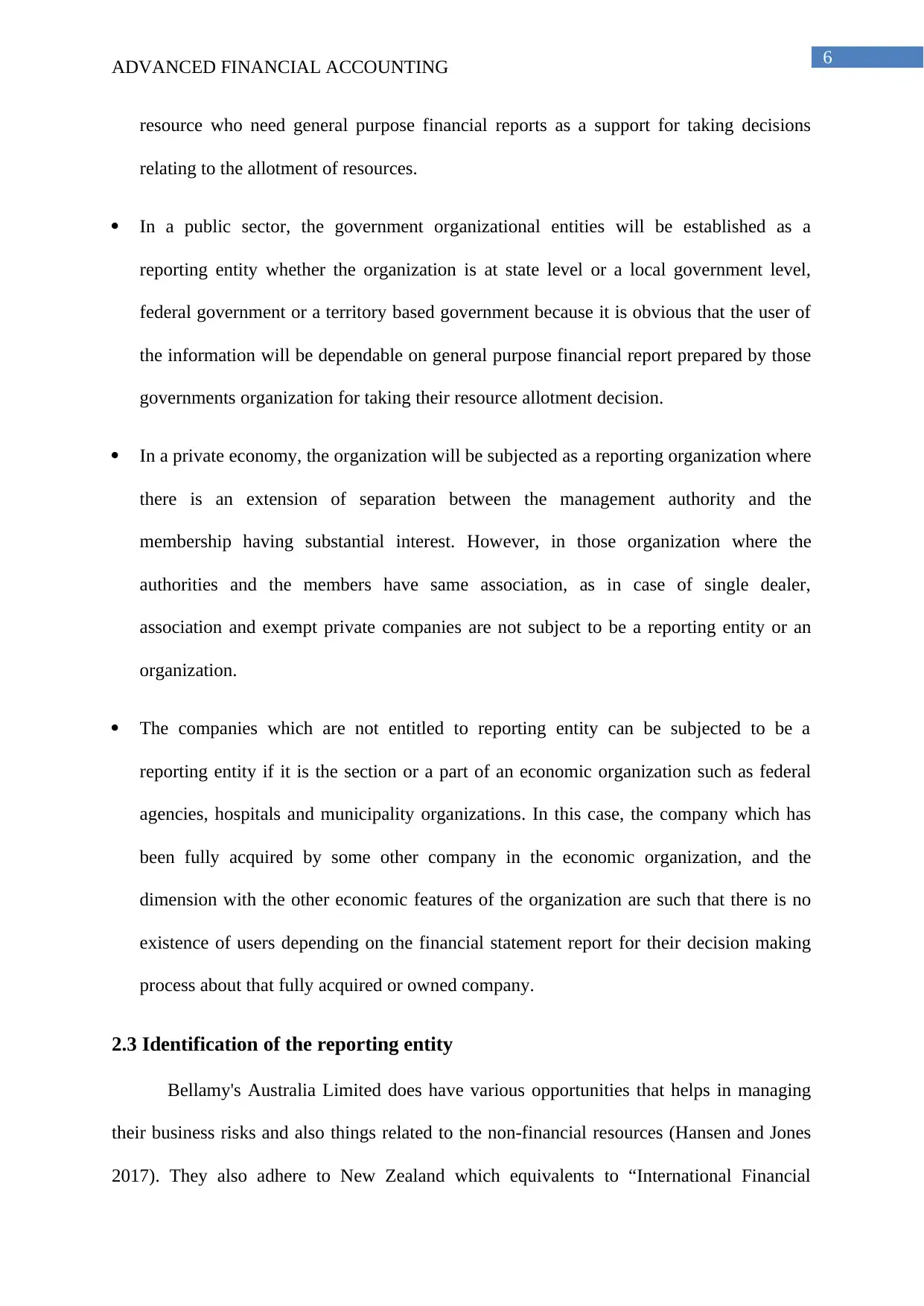
6
ADVANCED FINANCIAL ACCOUNTING
resource who need general purpose financial reports as a support for taking decisions
relating to the allotment of resources.
In a public sector, the government organizational entities will be established as a
reporting entity whether the organization is at state level or a local government level,
federal government or a territory based government because it is obvious that the user of
the information will be dependable on general purpose financial report prepared by those
governments organization for taking their resource allotment decision.
In a private economy, the organization will be subjected as a reporting organization where
there is an extension of separation between the management authority and the
membership having substantial interest. However, in those organization where the
authorities and the members have same association, as in case of single dealer,
association and exempt private companies are not subject to be a reporting entity or an
organization.
The companies which are not entitled to reporting entity can be subjected to be a
reporting entity if it is the section or a part of an economic organization such as federal
agencies, hospitals and municipality organizations. In this case, the company which has
been fully acquired by some other company in the economic organization, and the
dimension with the other economic features of the organization are such that there is no
existence of users depending on the financial statement report for their decision making
process about that fully acquired or owned company.
2.3 Identification of the reporting entity
Bellamy's Australia Limited does have various opportunities that helps in managing
their business risks and also things related to the non-financial resources (Hansen and Jones
2017). They also adhere to New Zealand which equivalents to “International Financial
ADVANCED FINANCIAL ACCOUNTING
resource who need general purpose financial reports as a support for taking decisions
relating to the allotment of resources.
In a public sector, the government organizational entities will be established as a
reporting entity whether the organization is at state level or a local government level,
federal government or a territory based government because it is obvious that the user of
the information will be dependable on general purpose financial report prepared by those
governments organization for taking their resource allotment decision.
In a private economy, the organization will be subjected as a reporting organization where
there is an extension of separation between the management authority and the
membership having substantial interest. However, in those organization where the
authorities and the members have same association, as in case of single dealer,
association and exempt private companies are not subject to be a reporting entity or an
organization.
The companies which are not entitled to reporting entity can be subjected to be a
reporting entity if it is the section or a part of an economic organization such as federal
agencies, hospitals and municipality organizations. In this case, the company which has
been fully acquired by some other company in the economic organization, and the
dimension with the other economic features of the organization are such that there is no
existence of users depending on the financial statement report for their decision making
process about that fully acquired or owned company.
2.3 Identification of the reporting entity
Bellamy's Australia Limited does have various opportunities that helps in managing
their business risks and also things related to the non-financial resources (Hansen and Jones
2017). They also adhere to New Zealand which equivalents to “International Financial
Paraphrase This Document
Need a fresh take? Get an instant paraphrase of this document with our AI Paraphraser
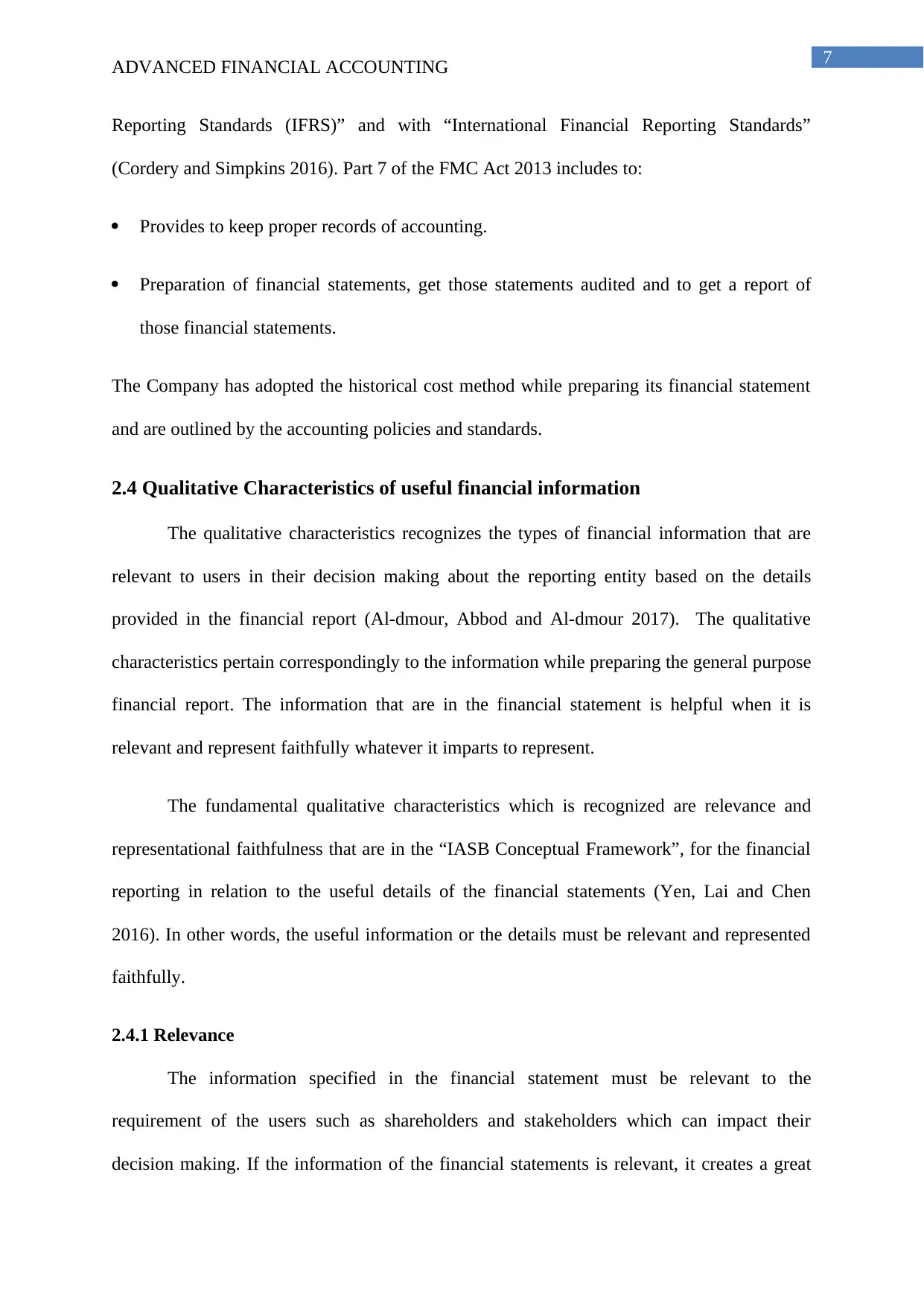
7
ADVANCED FINANCIAL ACCOUNTING
Reporting Standards (IFRS)” and with “International Financial Reporting Standards”
(Cordery and Simpkins 2016). Part 7 of the FMC Act 2013 includes to:
Provides to keep proper records of accounting.
Preparation of financial statements, get those statements audited and to get a report of
those financial statements.
The Company has adopted the historical cost method while preparing its financial statement
and are outlined by the accounting policies and standards.
2.4 Qualitative Characteristics of useful financial information
The qualitative characteristics recognizes the types of financial information that are
relevant to users in their decision making about the reporting entity based on the details
provided in the financial report (Al-dmour, Abbod and Al-dmour 2017). The qualitative
characteristics pertain correspondingly to the information while preparing the general purpose
financial report. The information that are in the financial statement is helpful when it is
relevant and represent faithfully whatever it imparts to represent.
The fundamental qualitative characteristics which is recognized are relevance and
representational faithfulness that are in the “IASB Conceptual Framework”, for the financial
reporting in relation to the useful details of the financial statements (Yen, Lai and Chen
2016). In other words, the useful information or the details must be relevant and represented
faithfully.
2.4.1 Relevance
The information specified in the financial statement must be relevant to the
requirement of the users such as shareholders and stakeholders which can impact their
decision making. If the information of the financial statements is relevant, it creates a great
ADVANCED FINANCIAL ACCOUNTING
Reporting Standards (IFRS)” and with “International Financial Reporting Standards”
(Cordery and Simpkins 2016). Part 7 of the FMC Act 2013 includes to:
Provides to keep proper records of accounting.
Preparation of financial statements, get those statements audited and to get a report of
those financial statements.
The Company has adopted the historical cost method while preparing its financial statement
and are outlined by the accounting policies and standards.
2.4 Qualitative Characteristics of useful financial information
The qualitative characteristics recognizes the types of financial information that are
relevant to users in their decision making about the reporting entity based on the details
provided in the financial report (Al-dmour, Abbod and Al-dmour 2017). The qualitative
characteristics pertain correspondingly to the information while preparing the general purpose
financial report. The information that are in the financial statement is helpful when it is
relevant and represent faithfully whatever it imparts to represent.
The fundamental qualitative characteristics which is recognized are relevance and
representational faithfulness that are in the “IASB Conceptual Framework”, for the financial
reporting in relation to the useful details of the financial statements (Yen, Lai and Chen
2016). In other words, the useful information or the details must be relevant and represented
faithfully.
2.4.1 Relevance
The information specified in the financial statement must be relevant to the
requirement of the users such as shareholders and stakeholders which can impact their
decision making. If the information of the financial statements is relevant, it creates a great
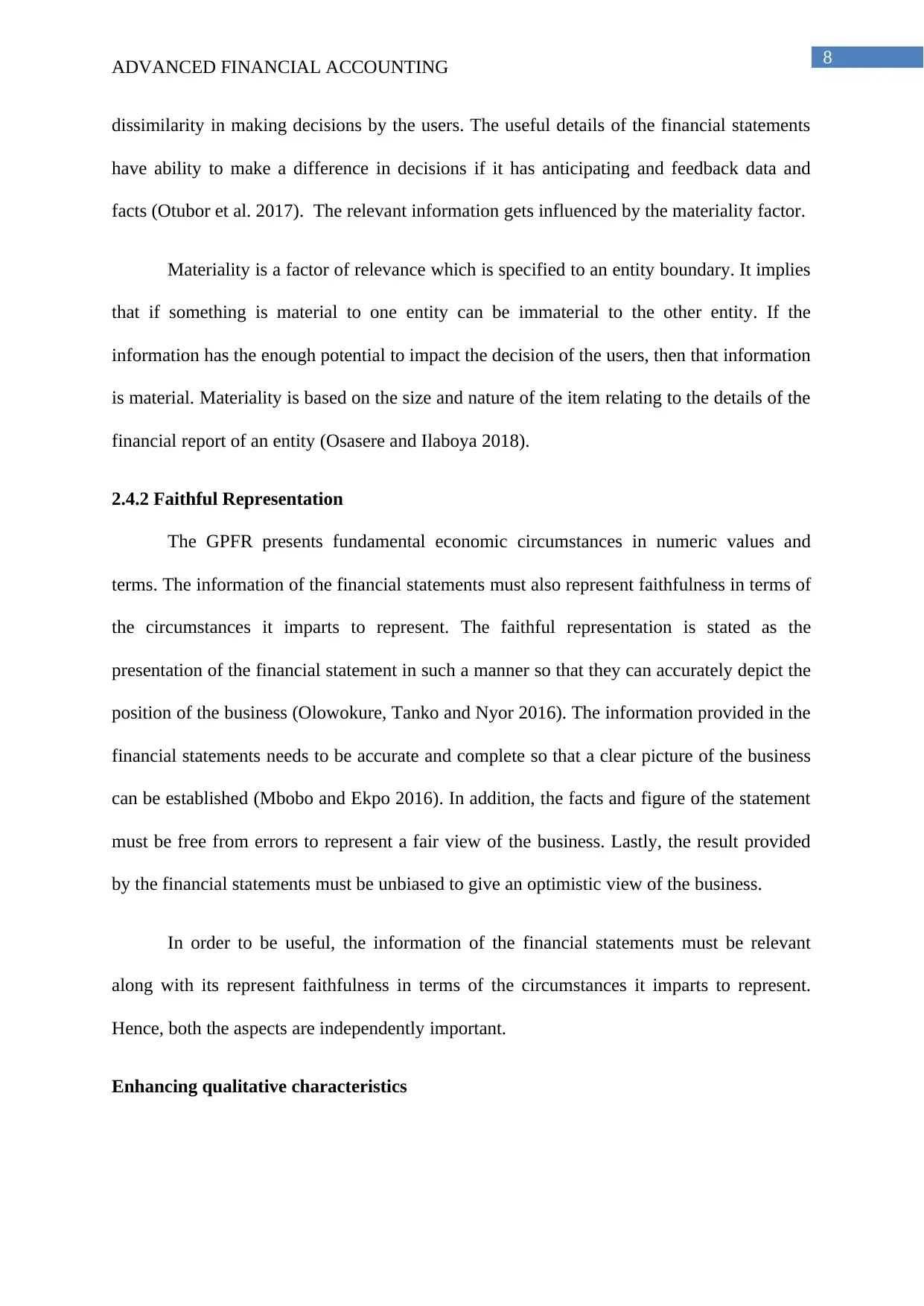
8
ADVANCED FINANCIAL ACCOUNTING
dissimilarity in making decisions by the users. The useful details of the financial statements
have ability to make a difference in decisions if it has anticipating and feedback data and
facts (Otubor et al. 2017). The relevant information gets influenced by the materiality factor.
Materiality is a factor of relevance which is specified to an entity boundary. It implies
that if something is material to one entity can be immaterial to the other entity. If the
information has the enough potential to impact the decision of the users, then that information
is material. Materiality is based on the size and nature of the item relating to the details of the
financial report of an entity (Osasere and Ilaboya 2018).
2.4.2 Faithful Representation
The GPFR presents fundamental economic circumstances in numeric values and
terms. The information of the financial statements must also represent faithfulness in terms of
the circumstances it imparts to represent. The faithful representation is stated as the
presentation of the financial statement in such a manner so that they can accurately depict the
position of the business (Olowokure, Tanko and Nyor 2016). The information provided in the
financial statements needs to be accurate and complete so that a clear picture of the business
can be established (Mbobo and Ekpo 2016). In addition, the facts and figure of the statement
must be free from errors to represent a fair view of the business. Lastly, the result provided
by the financial statements must be unbiased to give an optimistic view of the business.
In order to be useful, the information of the financial statements must be relevant
along with its represent faithfulness in terms of the circumstances it imparts to represent.
Hence, both the aspects are independently important.
Enhancing qualitative characteristics
ADVANCED FINANCIAL ACCOUNTING
dissimilarity in making decisions by the users. The useful details of the financial statements
have ability to make a difference in decisions if it has anticipating and feedback data and
facts (Otubor et al. 2017). The relevant information gets influenced by the materiality factor.
Materiality is a factor of relevance which is specified to an entity boundary. It implies
that if something is material to one entity can be immaterial to the other entity. If the
information has the enough potential to impact the decision of the users, then that information
is material. Materiality is based on the size and nature of the item relating to the details of the
financial report of an entity (Osasere and Ilaboya 2018).
2.4.2 Faithful Representation
The GPFR presents fundamental economic circumstances in numeric values and
terms. The information of the financial statements must also represent faithfulness in terms of
the circumstances it imparts to represent. The faithful representation is stated as the
presentation of the financial statement in such a manner so that they can accurately depict the
position of the business (Olowokure, Tanko and Nyor 2016). The information provided in the
financial statements needs to be accurate and complete so that a clear picture of the business
can be established (Mbobo and Ekpo 2016). In addition, the facts and figure of the statement
must be free from errors to represent a fair view of the business. Lastly, the result provided
by the financial statements must be unbiased to give an optimistic view of the business.
In order to be useful, the information of the financial statements must be relevant
along with its represent faithfulness in terms of the circumstances it imparts to represent.
Hence, both the aspects are independently important.
Enhancing qualitative characteristics
⊘ This is a preview!⊘
Do you want full access?
Subscribe today to unlock all pages.

Trusted by 1+ million students worldwide
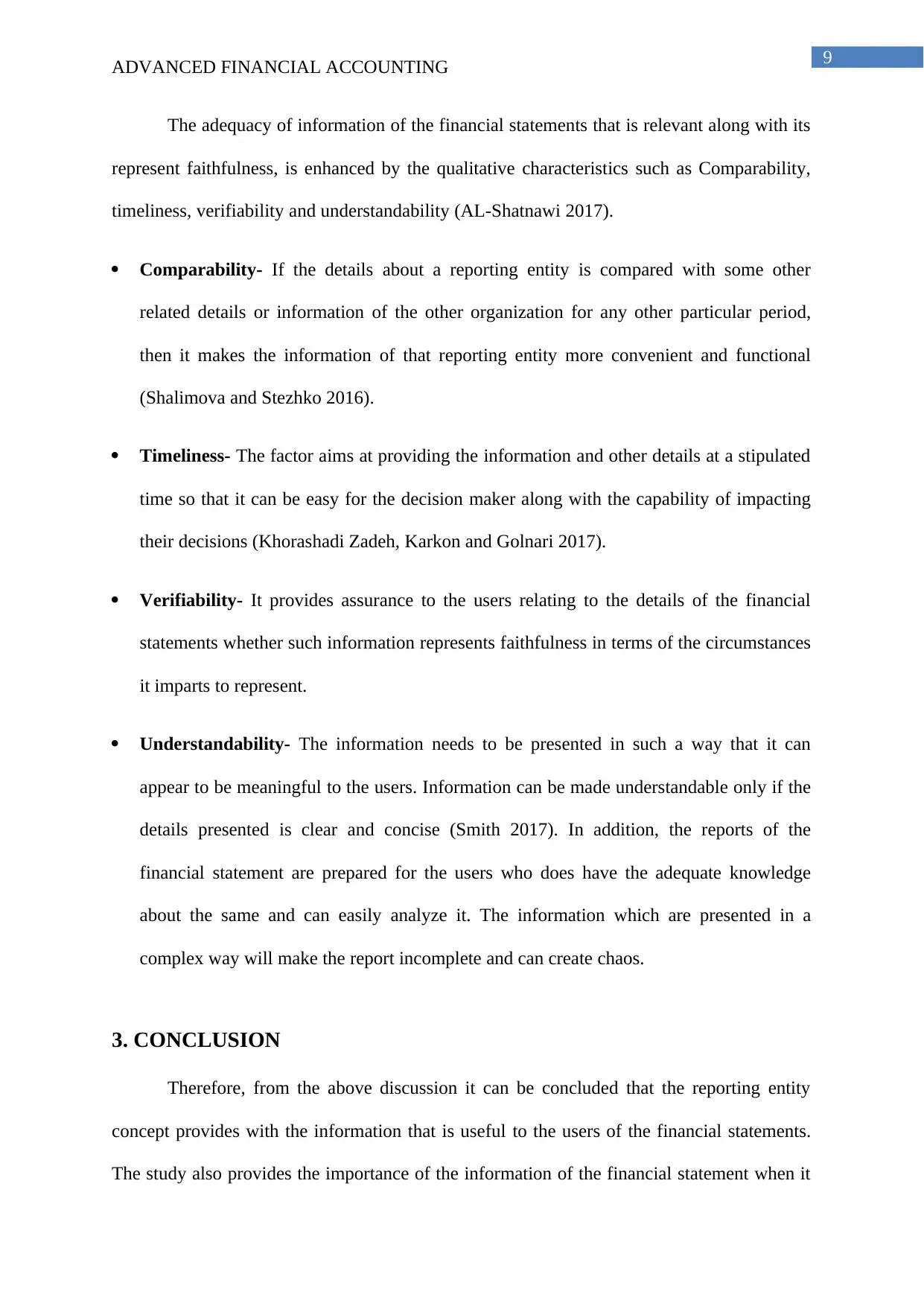
9
ADVANCED FINANCIAL ACCOUNTING
The adequacy of information of the financial statements that is relevant along with its
represent faithfulness, is enhanced by the qualitative characteristics such as Comparability,
timeliness, verifiability and understandability (AL-Shatnawi 2017).
Comparability- If the details about a reporting entity is compared with some other
related details or information of the other organization for any other particular period,
then it makes the information of that reporting entity more convenient and functional
(Shalimova and Stezhko 2016).
Timeliness- The factor aims at providing the information and other details at a stipulated
time so that it can be easy for the decision maker along with the capability of impacting
their decisions (Khorashadi Zadeh, Karkon and Golnari 2017).
Verifiability- It provides assurance to the users relating to the details of the financial
statements whether such information represents faithfulness in terms of the circumstances
it imparts to represent.
Understandability- The information needs to be presented in such a way that it can
appear to be meaningful to the users. Information can be made understandable only if the
details presented is clear and concise (Smith 2017). In addition, the reports of the
financial statement are prepared for the users who does have the adequate knowledge
about the same and can easily analyze it. The information which are presented in a
complex way will make the report incomplete and can create chaos.
3. CONCLUSION
Therefore, from the above discussion it can be concluded that the reporting entity
concept provides with the information that is useful to the users of the financial statements.
The study also provides the importance of the information of the financial statement when it
ADVANCED FINANCIAL ACCOUNTING
The adequacy of information of the financial statements that is relevant along with its
represent faithfulness, is enhanced by the qualitative characteristics such as Comparability,
timeliness, verifiability and understandability (AL-Shatnawi 2017).
Comparability- If the details about a reporting entity is compared with some other
related details or information of the other organization for any other particular period,
then it makes the information of that reporting entity more convenient and functional
(Shalimova and Stezhko 2016).
Timeliness- The factor aims at providing the information and other details at a stipulated
time so that it can be easy for the decision maker along with the capability of impacting
their decisions (Khorashadi Zadeh, Karkon and Golnari 2017).
Verifiability- It provides assurance to the users relating to the details of the financial
statements whether such information represents faithfulness in terms of the circumstances
it imparts to represent.
Understandability- The information needs to be presented in such a way that it can
appear to be meaningful to the users. Information can be made understandable only if the
details presented is clear and concise (Smith 2017). In addition, the reports of the
financial statement are prepared for the users who does have the adequate knowledge
about the same and can easily analyze it. The information which are presented in a
complex way will make the report incomplete and can create chaos.
3. CONCLUSION
Therefore, from the above discussion it can be concluded that the reporting entity
concept provides with the information that is useful to the users of the financial statements.
The study also provides the importance of the information of the financial statement when it
Paraphrase This Document
Need a fresh take? Get an instant paraphrase of this document with our AI Paraphraser
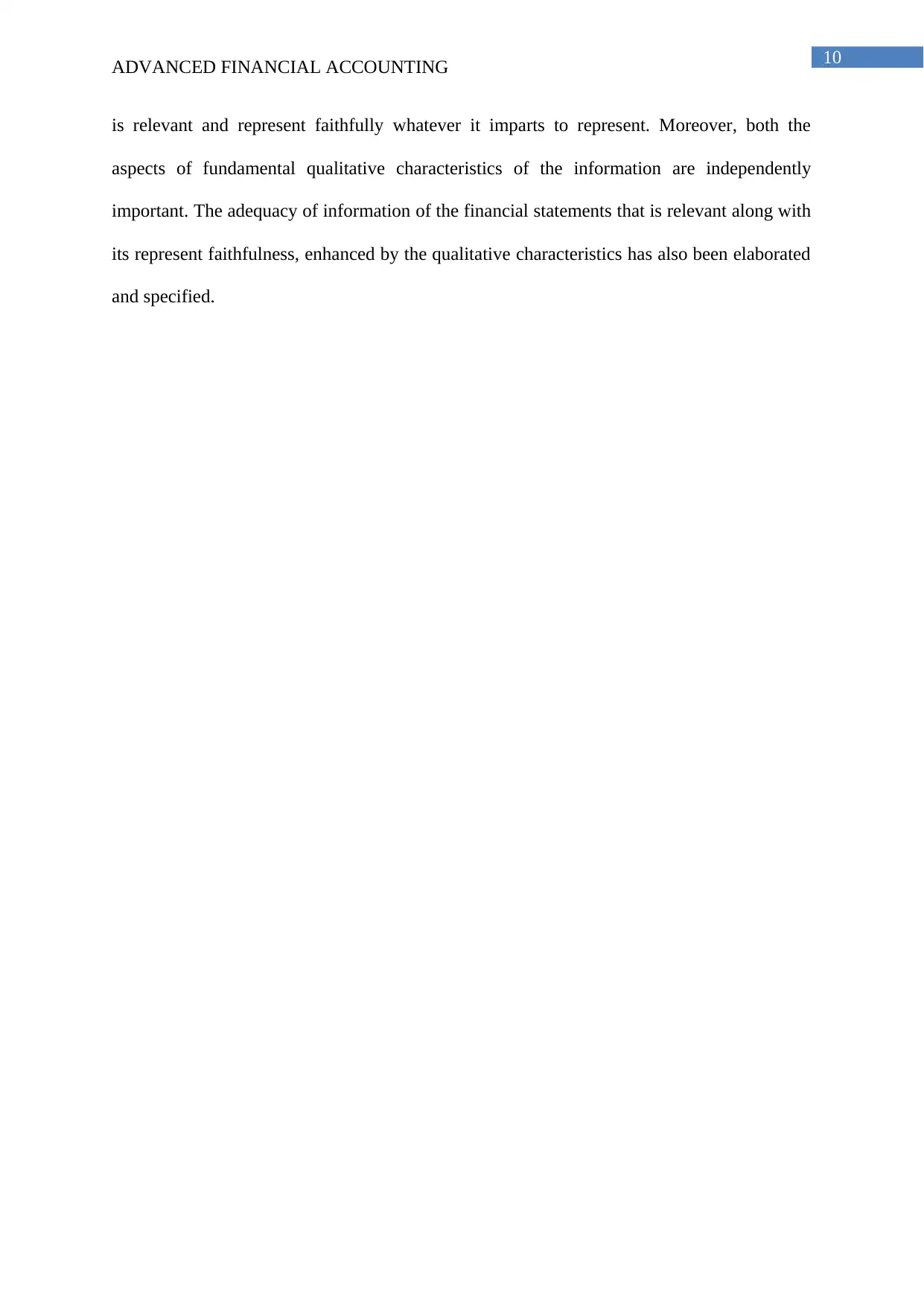
10
ADVANCED FINANCIAL ACCOUNTING
is relevant and represent faithfully whatever it imparts to represent. Moreover, both the
aspects of fundamental qualitative characteristics of the information are independently
important. The adequacy of information of the financial statements that is relevant along with
its represent faithfulness, enhanced by the qualitative characteristics has also been elaborated
and specified.
ADVANCED FINANCIAL ACCOUNTING
is relevant and represent faithfully whatever it imparts to represent. Moreover, both the
aspects of fundamental qualitative characteristics of the information are independently
important. The adequacy of information of the financial statements that is relevant along with
its represent faithfulness, enhanced by the qualitative characteristics has also been elaborated
and specified.
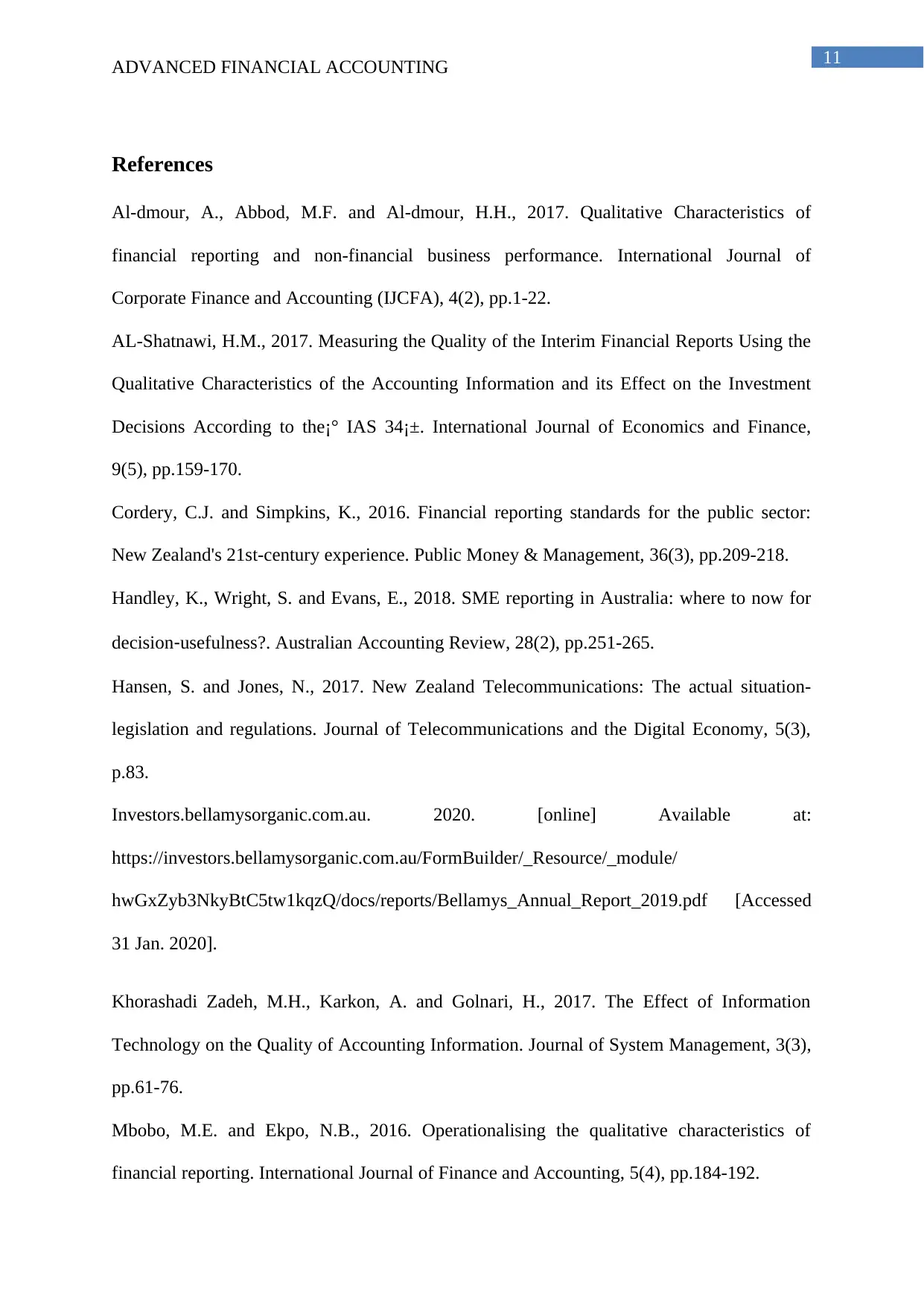
11
ADVANCED FINANCIAL ACCOUNTING
References
Al-dmour, A., Abbod, M.F. and Al-dmour, H.H., 2017. Qualitative Characteristics of
financial reporting and non-financial business performance. International Journal of
Corporate Finance and Accounting (IJCFA), 4(2), pp.1-22.
AL-Shatnawi, H.M., 2017. Measuring the Quality of the Interim Financial Reports Using the
Qualitative Characteristics of the Accounting Information and its Effect on the Investment
Decisions According to the¡° IAS 34¡±. International Journal of Economics and Finance,
9(5), pp.159-170.
Cordery, C.J. and Simpkins, K., 2016. Financial reporting standards for the public sector:
New Zealand's 21st-century experience. Public Money & Management, 36(3), pp.209-218.
Handley, K., Wright, S. and Evans, E., 2018. SME reporting in Australia: where to now for
decision‐usefulness?. Australian Accounting Review, 28(2), pp.251-265.
Hansen, S. and Jones, N., 2017. New Zealand Telecommunications: The actual situation-
legislation and regulations. Journal of Telecommunications and the Digital Economy, 5(3),
p.83.
Investors.bellamysorganic.com.au. 2020. [online] Available at:
https://investors.bellamysorganic.com.au/FormBuilder/_Resource/_module/
hwGxZyb3NkyBtC5tw1kqzQ/docs/reports/Bellamys_Annual_Report_2019.pdf [Accessed
31 Jan. 2020].
Khorashadi Zadeh, M.H., Karkon, A. and Golnari, H., 2017. The Effect of Information
Technology on the Quality of Accounting Information. Journal of System Management, 3(3),
pp.61-76.
Mbobo, M.E. and Ekpo, N.B., 2016. Operationalising the qualitative characteristics of
financial reporting. International Journal of Finance and Accounting, 5(4), pp.184-192.
ADVANCED FINANCIAL ACCOUNTING
References
Al-dmour, A., Abbod, M.F. and Al-dmour, H.H., 2017. Qualitative Characteristics of
financial reporting and non-financial business performance. International Journal of
Corporate Finance and Accounting (IJCFA), 4(2), pp.1-22.
AL-Shatnawi, H.M., 2017. Measuring the Quality of the Interim Financial Reports Using the
Qualitative Characteristics of the Accounting Information and its Effect on the Investment
Decisions According to the¡° IAS 34¡±. International Journal of Economics and Finance,
9(5), pp.159-170.
Cordery, C.J. and Simpkins, K., 2016. Financial reporting standards for the public sector:
New Zealand's 21st-century experience. Public Money & Management, 36(3), pp.209-218.
Handley, K., Wright, S. and Evans, E., 2018. SME reporting in Australia: where to now for
decision‐usefulness?. Australian Accounting Review, 28(2), pp.251-265.
Hansen, S. and Jones, N., 2017. New Zealand Telecommunications: The actual situation-
legislation and regulations. Journal of Telecommunications and the Digital Economy, 5(3),
p.83.
Investors.bellamysorganic.com.au. 2020. [online] Available at:
https://investors.bellamysorganic.com.au/FormBuilder/_Resource/_module/
hwGxZyb3NkyBtC5tw1kqzQ/docs/reports/Bellamys_Annual_Report_2019.pdf [Accessed
31 Jan. 2020].
Khorashadi Zadeh, M.H., Karkon, A. and Golnari, H., 2017. The Effect of Information
Technology on the Quality of Accounting Information. Journal of System Management, 3(3),
pp.61-76.
Mbobo, M.E. and Ekpo, N.B., 2016. Operationalising the qualitative characteristics of
financial reporting. International Journal of Finance and Accounting, 5(4), pp.184-192.
⊘ This is a preview!⊘
Do you want full access?
Subscribe today to unlock all pages.

Trusted by 1+ million students worldwide
1 out of 13
Related Documents
Your All-in-One AI-Powered Toolkit for Academic Success.
+13062052269
info@desklib.com
Available 24*7 on WhatsApp / Email
![[object Object]](/_next/static/media/star-bottom.7253800d.svg)
Unlock your academic potential
Copyright © 2020–2025 A2Z Services. All Rights Reserved. Developed and managed by ZUCOL.





